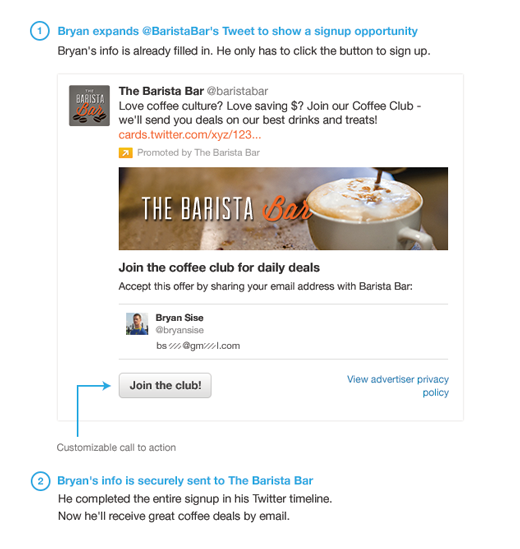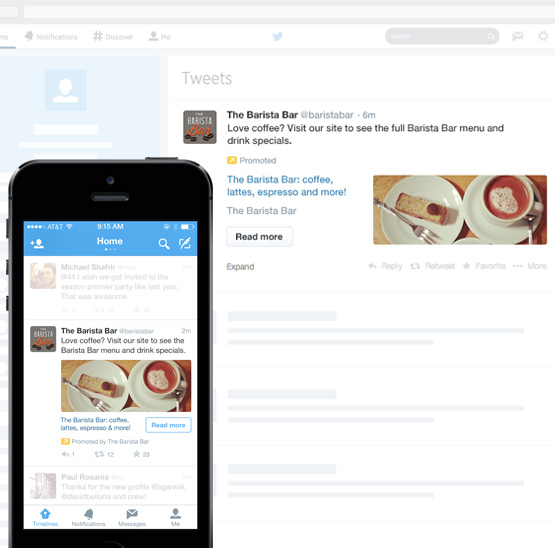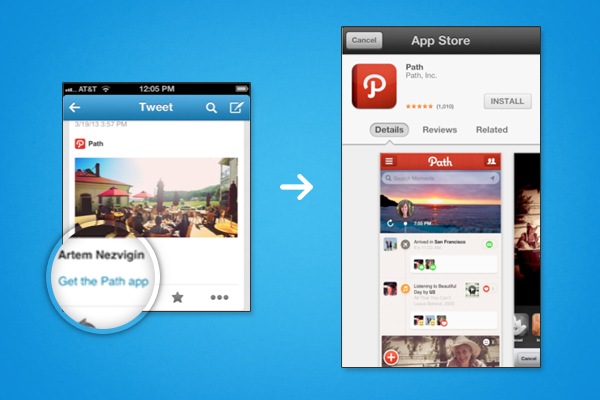Twitter Ads has been my personal muse for some time now, and that notion hasn’t slowed down one bit. Why? Much like their counter parts at Facebook, the Twitter Ads team continues to innovate and drive their advertising platform forward. Seriously, I catch myself mumbling, “where do they get all of those wonderful toys!”
The base ad platform hasn’t changed much over the past couple of years. Keyword targeting for search and user timelines. Target interests or users similar to the followers of specific Twitter profiles. Etc., etc.. There have been innovations (e.g. device targeting, honed keyword targeting, etc.), but the base has been just that – a foundation upon which a bunch of exciting new features have been built.
In that vein, here are 6 Twitter Ads features that have me geeked out:
- Lead Gen Cards: Social media is becoming more and more a visual medium. Pictures and videos are attractive and get more attention as users scroll through their Facebook, Twitter or LinkedIn feeds. Given this fact, it’s no wonder that the most effective social ad unites are those that incorporate images. But what if you could combine an image AND a very efficient conversion event for the end user? Powerful stuff.
 Twitter’s Lead Gen cards present the user with an image, relevant promoted tweet copy and a call-to-action button. With a push of that button the user grants permission for their name, Twitter handle and email address to be sent to you, the advertiser in exchange for something. Perhaps being added to an email newsletter, downloading a whitepaper or requesting to be contacted – the possibilities are only limited by your imagination. What makes this ad unit even more special is that you can have the data submitted directly to your internal database or CRM platform. Has it ever been easier to generate conversions and collect data? I think not. (image courtesy of the Twitter Ads Blog)
Twitter’s Lead Gen cards present the user with an image, relevant promoted tweet copy and a call-to-action button. With a push of that button the user grants permission for their name, Twitter handle and email address to be sent to you, the advertiser in exchange for something. Perhaps being added to an email newsletter, downloading a whitepaper or requesting to be contacted – the possibilities are only limited by your imagination. What makes this ad unit even more special is that you can have the data submitted directly to your internal database or CRM platform. Has it ever been easier to generate conversions and collect data? I think not. (image courtesy of the Twitter Ads Blog) - Website Cards: For many of us, a name and an email just isn’t enough information to qualify a lead or a prospect. We need a phone number, place of business or some other vital piece of information. In this case we still need to follow the typical route of sending our paid traffic to a landing page separate from Twitter. If the Lead Gen Card is out, we still want to generate the best engagement rates possible, so that means using images. In a traditional promoted tweet, images are considered a link. Any click on the image counts as an engagement that you have to pay for. When your goal is to send traffic to a landing page, this is expensive and frankly, pointless.

In comes the Website Card. You get all the pizazz of the Lead Gen Card (image, call-to-action button and more!) minus the lead submission. Instead, clicks on the ad unit take the user directly to your website. These ad unites are clean and simple and quite effective. (image courtesy of the Twitter Ads Blog) - Mobile App Cards: Advertising a mobile app? Listen up. Not to be outdone by Facebook and their ads for apps, Twitter has created app cards in two flavors. The “Basic App” and the “Image App” – spoiler alert, the Image App includes an image! In both instances, you plug in credentials for iOS App Store or Google Play and Twitter sucks in all of the relevant information. The Image App card then allows you to upload a custom image to enhance the ad unit.

(image courtesy of the Twitter Ads Blog) - Conversion Tracking: Conversion tracking is fundamental to digital advertising. But for whatever reason all of the major social advertising players have been slow to create/adopt conversion tracking solutions. Facebook struck first, failed. Then struck again making it stick the second time around. Twitter got their act together in advance of their IPO last fall and created a conversion tracking solution that works… on the first try. You can create multiple conversion events with multiple codes. If you are familiar with Google AdWords conversion tracking, this will be a piece of cake.
- Audience Creation & Targeting: Remarketing FTW! Twitter killed two birds with one stone when they created their conversion tracking system. Utilizing the exact same coding system, you can tag your entire website and build an audience for remarketing. When you create a tag, you designate if you want that tag to build a “tailored audience” for future targeting (or exclusion). If you haven’t joined this bandwagon yet, please do.
- 3rd Party Audience Link: If you’re lazy and don’t feel like adding another tag to your website for remarketing purposes, there’s still hope. Twitter has created a process by which you can link remarketing audiences from providers like AdRoll and Perfect Audience to advertise against. Easy peasy.
Facebook is still seen as the powerhouse in the social ads marketplace. And for good reason. But Twitter Ads is providing a very strong platform for reaching a targeted audience. And perhaps most importantly, tracking the performance of those campaigns. It took Facebook a long time to figure that piece out. And LinkedIn? Well… perhaps they’ll get there someday?
What will Twitter Ads come up with next? I’ve got no clue, but I’m excited to find out. What have been your experiences with Twitter ads? Please share in the comments!
John Lee
Latest posts by John Lee (see all)
- Travel PPC: 3 Ways to Inspire Family Travel Planners to Buy Your Vacation - February 21, 2017
- What’s Going On! Is Google AdWords Squeezing Out 3rd Party Tracking? - March 11, 2015
- PPC Growth Hacking: Building a Community Through Shared Knowledge - August 12, 2014
- Where Do They Get All Those Wonderful Toys? A Twitter Ads Refresher - July 31, 2014

[…] Where Does Twitter Ads Get All Those Wonderful Toys?, http://www.thesempost.com […]